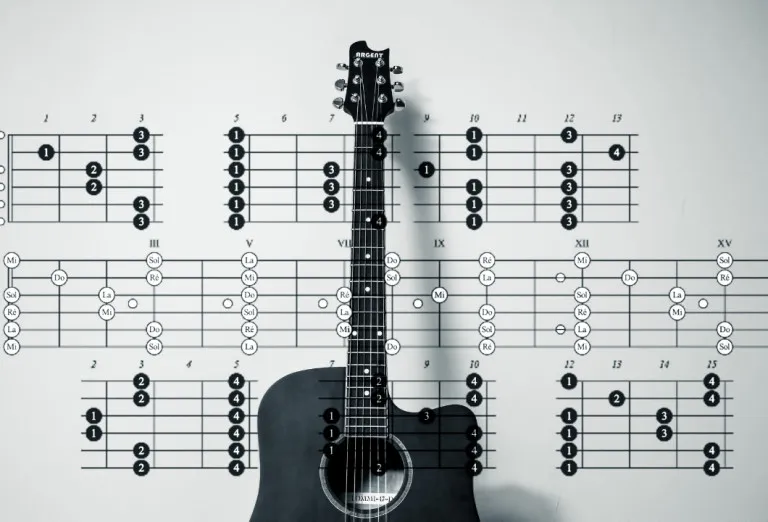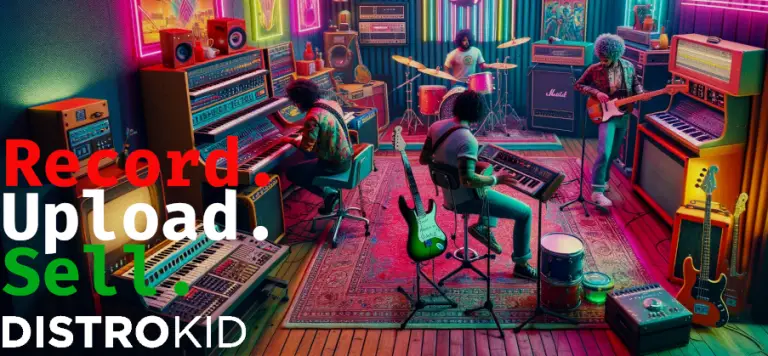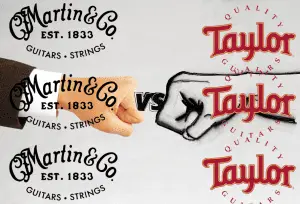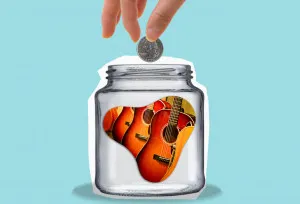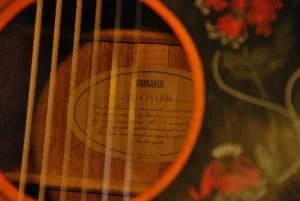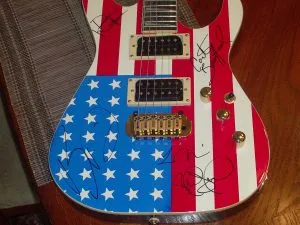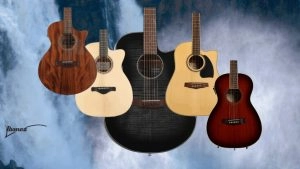Have you ever listened to a song and thought to yourself, “This sounds like another song!”? Chances are, they share the same chord progression. They could use the exact same chords or just occupy the same positions in the scale.

In reality, most songs use similar progressions, especially in popular music. So, as a beginner musician, learning the right progressions can be a shortcut to mastering a ton of songs.
In this article, we will teach you how certain progressions fit together, why they work, and how to play them in a few different keys. Read on to learn all there is to know about mastering a progression.
• • •
What is a Guitar Chord Progression?
A chord progression is simply a collection of chords in the same key. As you learn more songs, you may start to notice repeated patterns, even among vastly different styles. Even if songs are in different keys, they can use the same framework for their progressions.
The Root of It All

The root chord of a progression is usually the first chord you play. This will help you identify whether your progression is in a Major or minor key. For example, if it starts with an A chord the progression is likely Major. If it starts with Em, then it’s in a minor key.
All of this is known as the tonic chord for the progression.
Yet, this isn’t always true and can be a little confusing. Instead, you could think of it as:
- Major keys sound “uplifting” or “optimistic.”
- Minor keys sound “sad” or “pessimistic.”
The Anatomy of a Chord Progression
Just like how you pick notes from a scale to form a single chord, you use several chords within a scale to create a progression. When building or talking about a chord progression, you’ll usually see each chord is associated with a roman numeral of one through to seven. This is to represent each chord in the scale and is known as degrees.
Major Keys — I – ii – iii – IV – V – vi – vii°
Minor Keys — i – ii° – III – iv – V – VI – VII
Note: The degree symbol represents diminished chords.
You’ll notice that some are in capital letters and some are in lower case. For now, you just have to know that the capitals are major chords and the lower case are minors. We could dive into the musical theory behind this, but it’s more important to get you playing for now.
If you don’t understand what numbers represent, think about an octave. Eight notes make up an octave. That includes the octave of the root note, though, so there are actually seven.
Seven notes in the scale and seven roman numerals. Are you getting the picture? Let’s take a look at the C Major scale as it’s the simplest to understand.
The C Major scale consists of these notes:
C – D – E – F – G – A – B
If we overlay that with the roman numerals of (remember capitals are major and lower case are minors):
I = C ii = Dm iii = Em IV = F V = G vi = Am vii° = Bdim
While you don’t need to have this in your mind every time you learn a progression, it will help you master them faster. It will also help you to change keys to match your voice if you want to sing along to songs that don’t match your range.
There are, of course, other keys that use different notes in the octaves and more complex chords. But, for the bulk of songs, the above rules apply, especially if you’re a beginner.
• • •
4 Common Progressions – The Ones to Practice First
You’ll often run into the exact same progressions in most styles of popular music. It’s strange to think that metal, pop, country, blues, and even jazz share such characteristics, but it’s true.
As a cover musician, I use this to my advantage all the time by building unexpected mashups of songs that use the same progressions.
With that in mind, let’s take a look at some of the most common chord progressions you’ll see.
Major Progressions (I – V – vi – IV)
This is likely the most common Major progression. You’ll notice it in literally thousands of songs when you know what to listen for. As you progress in your guitar journey, you’ll definitely begin to be able to pick it by ear when you’re listening to songs on the radio.
The most common version of this progression that newer players learn is:
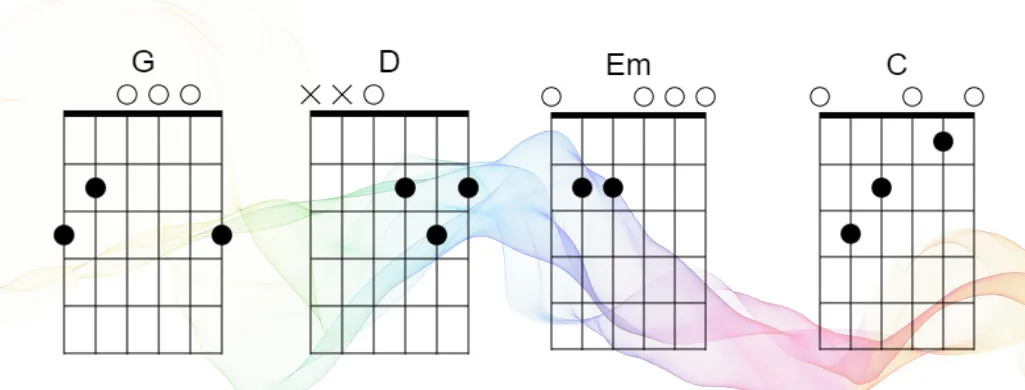
G – D – Em – C
This one doesn’t require any barre chords to play, so it’s among the easiest for newbies. Once you learn how to play an F, another very common version is the C Major chord progression:
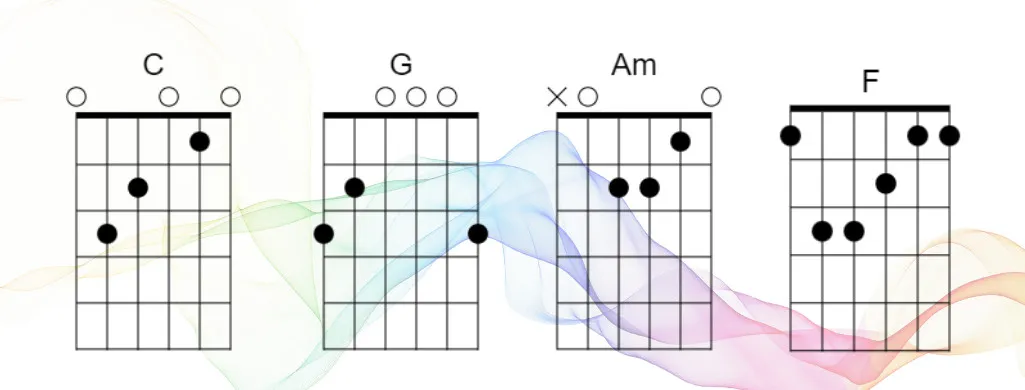
C – G – Am – F
If you learn these two chord progressions and master the transitions, you’ll have taken a few huge steps towards being an intermediate player. If you use a capo, you’re likely to be able to play hundreds of songs—just like that.
You wouldn’t believe how many songs can be played with this progression. Some of them include:
- U2 – With or Without You
- Jason Mraz – I’m Yours
- Andrea Bocelli – Con te partir
There are other common four-chord progressions that use the I – V – vi – IV chords in a different order too. Mastering the main chords here will help you tackle those progressions too. One of the most common ways that this comes up is with something called relative minors.
Minor Progressions (i – VI – III – VII)
This is among the most prevalent chord progressions for songs in a minor key. It’s just as common as the previous examples across many genres and songs. Among the most common is:
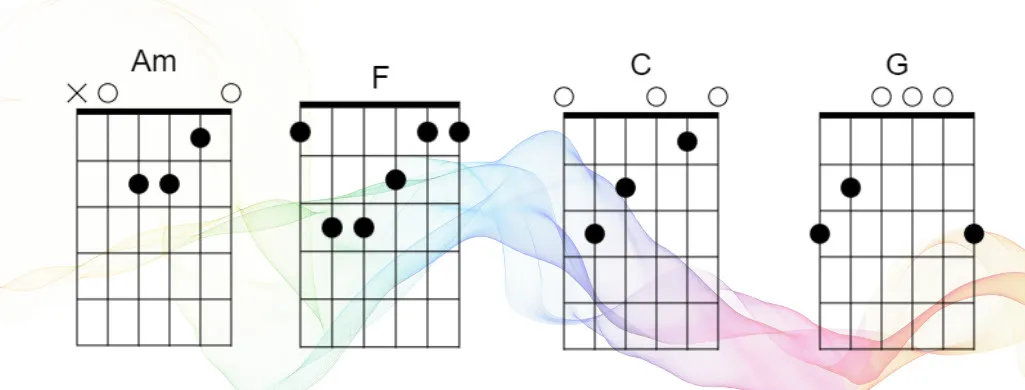
Am – F – C – G
You may notice that this progression uses the same chords as the second example in the major progression we discussed earlier. This is because Am is the relative minor of the key of C.
You don’t have to fully understand what a relative minor means to master chord progressions. Just note that the chords are the same but in a different order. So, that means you can learn to experiment with chord progressions on your own by rearranging the chords.
Again, if you want to avoid barre chords, you could play:
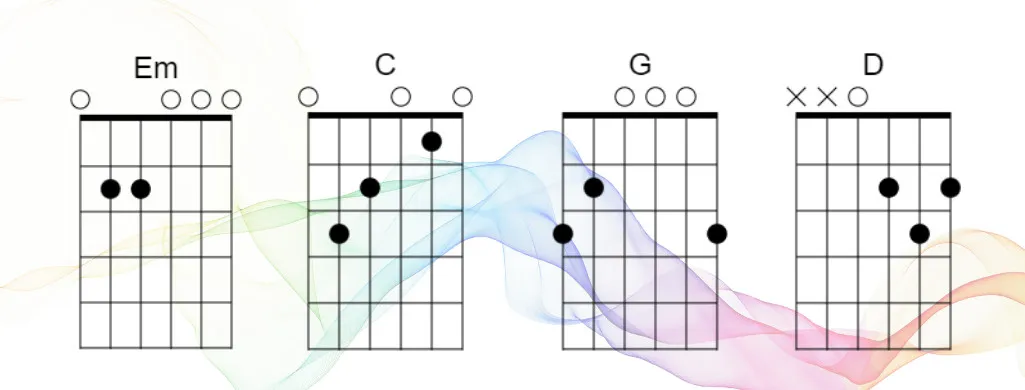
Em – C – G – D
Here are a few songs that use this progression:
- “Save Tonight” by Eagle Eye Cherry
- “Otherside” by Red Hot Chilli Peppers
- “Wake Me Up” by Avicii
Learning About Relative Minors and Your Fretboard at the Same Time
It’s good practice for your ear and fretboard knowledge to find the relative minor of a Major key and vice versa. The gap between the relative major and minor is always the same.
For example, one of the C notes on your guitar is the 8th fret on the bottom string. As we discussed, the relative minor of C Major is A minor. And, there is an A or the 5th fret of the bottom string—3 frets difference.
You can apply this concept to find the relative Major and minor up and down the fretboard for any key.
• • •
Using Power and Barre Chords to “Cheat” When Changing Keys
Barre chords are hard for beginners. But, if they’re something that you’ve already mastered, they can help you identify progression patterns easier.
If you can’t play barres yet, you can use power chords, and it will sound close enough until your hands get a little stronger.
Let’s look at the progression of C – G – Am – F as an example. The root notes for each barre goes as follows:
- C – third fret on the A string
- G – third fret on the bottom E string
- Am – fifth fret on the bottom E string
- F – first fret on the bottom E string
If you were to learn that progression, your hand would become accustomed to the pattern while moving around the fretboard.
Now let’s say you wanted to play the same pattern in a different key. Your muscle memory would allow you to do that without having to think too much. You would just have to figure out where the root chord is on the fretboard.
For example, let’s say you wanted to play the same progression in the key of D Major. You could just play the same pattern in the gaps between frets and Major and minor chords but start on the fifth fret of the A string. It would look like this:
- D – fifth fret on the A string
- A – fifth fret on the bottom E string
- Bm – seventh fret on the bottom E string
- G – third fret on the bottom E string
As you can see, the relative position of each chord stays the same.
We’re going to give some more examples of some chord progressions to learn and focus primarily on open chords. But, it’s a fantastic idea to also use barre chords and power chords for the reason mentioned above.
Doing so will also help you to learn the notes on your fretboard. You’ll also increase your finger strength and endurance by playing more barre chords.
• • •
13 Common Chord Progressions Guitar Players Use
Now that you understand a little more about how chord progressions work let’s take a gander at some more easy chord progressions for you to try. In each, we’ll give the degrees from the root note and an example of how that fits into a particular key.
Again, you can experiment by moving the chords around the fretboard and finding the relative chords to boost your overall guitar knowledge and skills.
The Backbone of Blues
Blues is the origin of many other popular styles of music, and the most important part of a blues song is the chords that make it. Learning the following blues-based chords will get you a headstart for several other genres too.
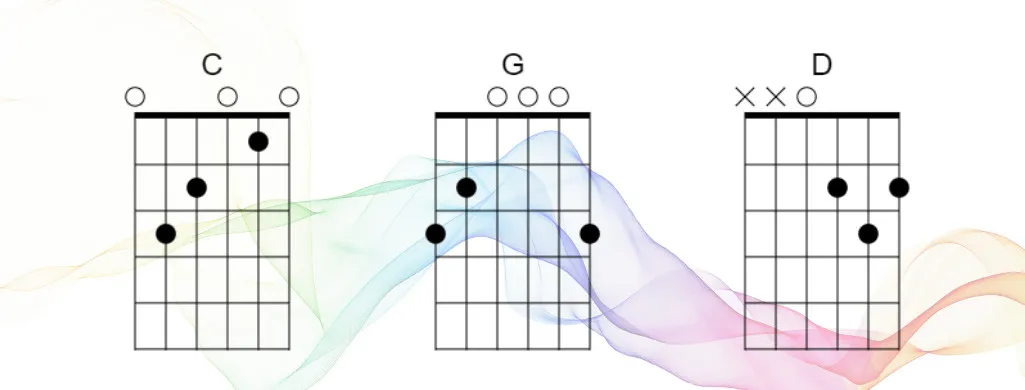
I – IV – V (G – C -D)
This blues chord progression is common across the entire genre. It is one of the main ingredients of the overall meal that is 12 bar blues. But, blues songs are not the only place you’ll find it.
Many other genres borrow from blues in plenty of ways, which doesn’t exclude chord progressions. You’ll find this particular G Major chord progression in songs like:
- “Hound Dog” by Elvis Presley
- “Johnny B Goode” by Chuck Berry
- “Stuck in the Middle with You” by Stealers Wheel
There are plenty more examples if you change the key too—experiment playing this progression with a little bit of swing to optimize the bluesy feel while you play.
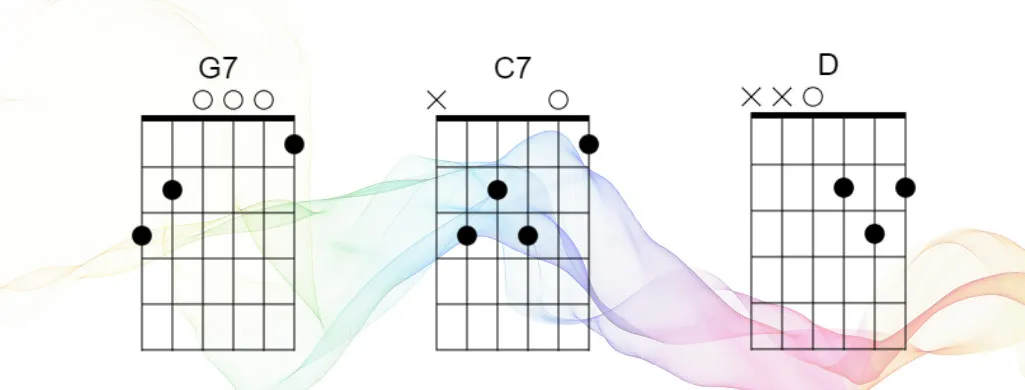
I7 – IV7 – V (G7 – C7 – D)
This is the same as the previous I IV V chord progression, but with some sevenths instead of Major chords. Blues music usually has a lot of seventh chords in it and can often be in the meat of the chord pattern such as above. Other blues progressions resolve on a seventh just to give that sense of urgency to the end that you may be familiar with.
• • •
Funk Chord Progressions
Although these progressions may look familiar, Funk is more about how you play the guitar than the chord progressions themselves. Keep that in mind as you experiment with the following common chord progressions for funk.
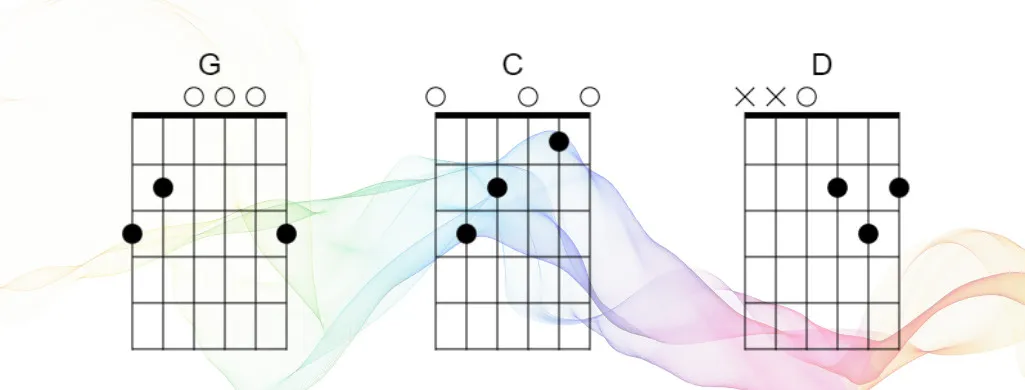
I – IV – V (G – C – D)
As I said, it’s not just blues progressions that fit this mold. The difference when you’re playing funk on guitar is how you play the chords, instead of playing open chords or barre chords, you should focus on playing triads on the three thinnest strings.
This is because funk is normally played in a band setting, so there needs to be space in the soundscape for the other instruments to fit without becoming muddled together.
It may sound a little thin when playing on your own, but you’ll recognize that it fits with what the greats played.
You can catch this I IV V progression in songs like: “Papa’s Got a Brand New Bag,” and “I Feel Good,” by James Brown.
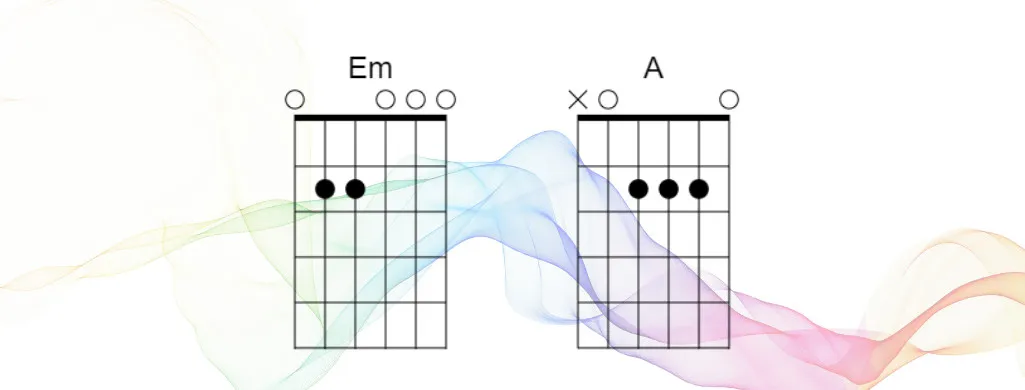
i – IV (Em – A)
Funk music has so much going on with the other instruments that a simple two-chord pattern like this Em progression is all you need from the guitar. There are plenty of funk songs that just use two chords for the bulk of the guitar parts. One classic example is “Thank You” by Sly Stone.
• • •
Pop and Rock Chord Progressions
As much as heavy rockers may want to deny it, pop and rock music have a lot in common regarding chord progressions. Sure, the instrumentation and the strumming patterns may be different. Yet, the chords are the same.
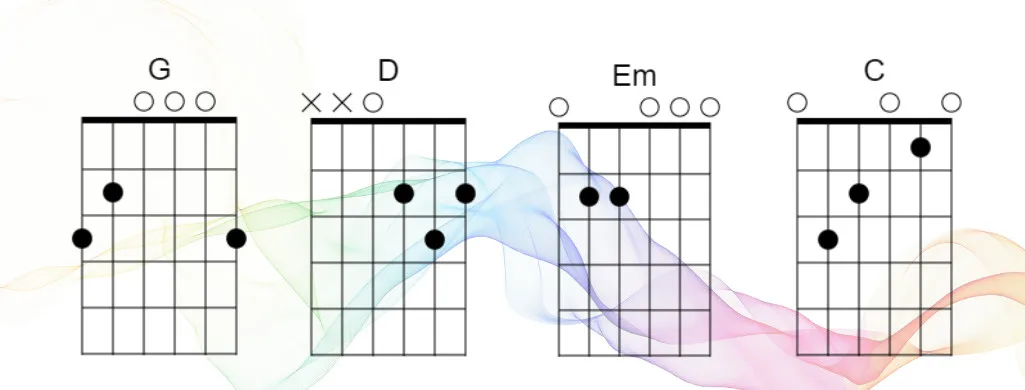
I – V – vi – IV and All Its Variations (G – D – Em – C)
As we discussed earlier in this article, pretty much every popular song ever written can be played with these four chords. You’d just have to adjust the key with your capo, and you’d even be able to use the same chord shapes every time.
Now, not every rock and pop song uses these chords. Some have fewer chords, some change it up in the bridge, some even have key changes in the middle of the track. However, there is no better progression to learn to kick start your learning as a beginner.
Shake it up a little once you get comfortable starting on a G chord. Maybe try an A Major chord progression with the same spacings, then try a D Major chord progression, etc.
Even songs in a minor key can be represented with these four chords. You could ignore the roman numerals and just wing it starting on the minor chords (Em in the example). We guarantee you’ll hear a song you know in your head if you played long enough.
So, once you’re done learning all the major keys, tackle the minor ones by rearranging the chords. Perhaps start with a B minor chord progression so you can practice your bar chords too.
• • •
Common Progressions for Country Music

I – V – vi – IV (G – D – Em – C)
It shouldn’t come as a surprise that one of the most prevalent country chord progressions is the classic four-chord pattern synonymous with popular music. Despite the unwarranted hatred directed towards it by those that aren’t fans, it has many similarities to pop and rock music.
If you’ve already mastered this chord progression, you’re well on the way to becoming a country artist. Here are a couple of songs that use this progression:
- “Out of the Woods” by Taylor Swift
- “What about Now” by LoneStar
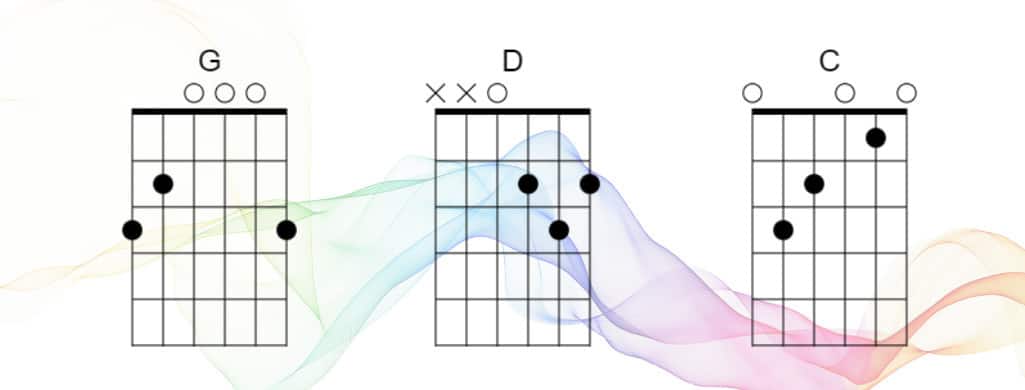
I – V – IV (G – D – C)
Country music often contains good vibes in the lyrics and the overall music. So, it makes sense that a lot of these songs only contain majors.
This particular variation uses a G as the tonic and provides a major sound. These three chords give the right kind of feeling to match such country classics as “Chicken Fried” by Zac Brown Band.
• • •
Indie Progressions
Alongside the jangly tone we associate with indie guitarists, they use similar chord progressions to rock and pop music. It’s not uncommon for them to throw in some sevenths and major sevenths to mix things up a little, though.
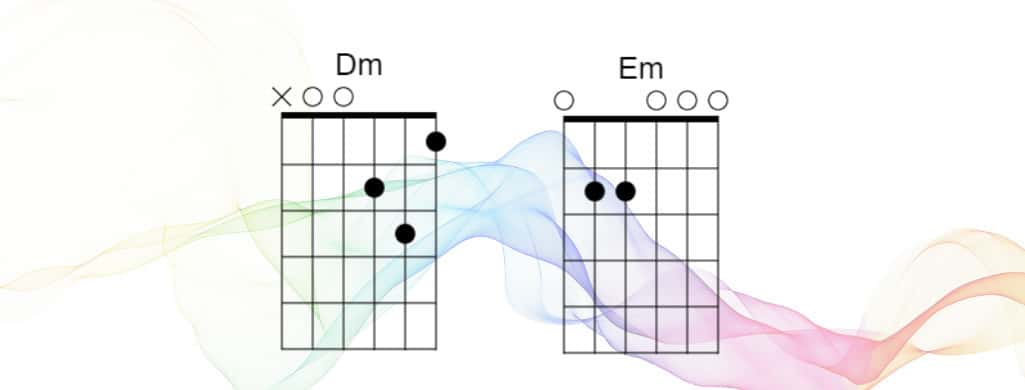
iv – v (Dm – Em)
It’s common practice in Indie music to use simple chords, and not many of them. But, a seemingly easy two-chord progression has a little more to it.
The key of Dm does not contain an Em chord, nor is the opposite true.
So, although verses in songs such as “505” by The Arctic Monkeys don’t play an Am at all, that is the tonic chord.
This is a prime example of how you can create exciting music by breaking the mold a little but not making it too abstract (looking at you jazz!).
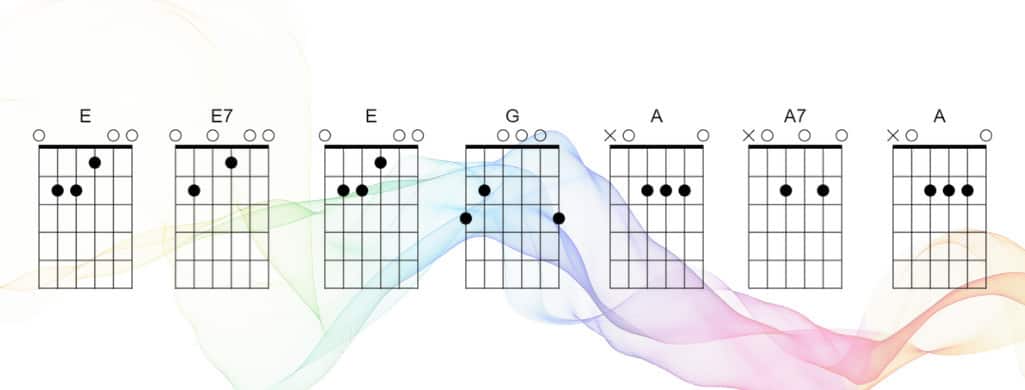
I – I7 – I – biii – IV – IV7 – IV (E – E7 – E – G – A – A7 – A)
This is another progression that looks a lot harder than it is. To build and take away the sevenths, you just have to hammer and pull off with your index finger. This is an important skill to practice to improve your guitar playing and add flavor.
You may also have noticed that we referenced biii in this progression. That means the chord is a flat third of the scale. Think of it as borrowing the chord from the relative minor. It works, but only as a chord in passing. It shouldn’t be the centerpiece of the progression when writing your own.
Many blues artists use this technique too. To understand what it sounds like under the context of indie, try listening to “Anemone” by Brian Jonestown Massacre.
• • •
Jazz Progressions for Guitar
Jazz is all about understanding the rules of music and breaking them in the right way. Jazz musicians do things a little differently from other musical genres. This is where you’ll start to see some variations and interpretations of how they’re played.
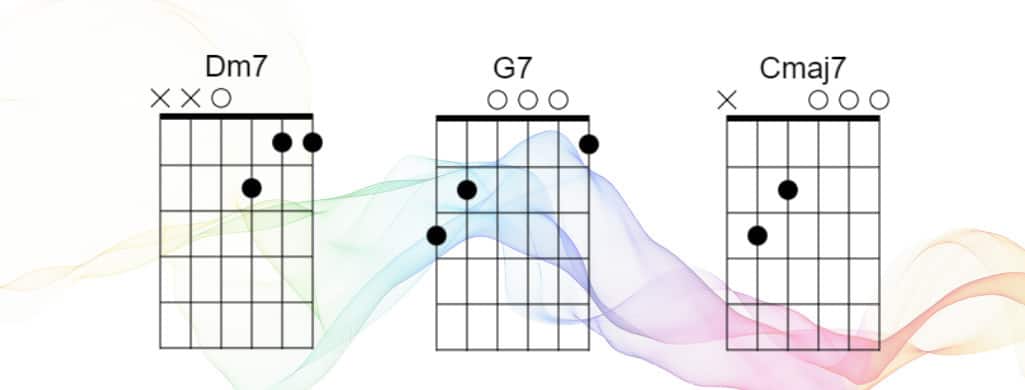
ii7 – V7 – Imaj7 (Dm7 – G7 – Cmaj7)
You can see that in this jazz progression the tonic is not the first one you play. You can pick that this is the tonic as it is often played for two bars while the others are only played for one each, so there is more emphasis on it.
Many jazz progressions use sevenths just like this one does. So, just like with blues, if you love Jazz, you’d better get used to playing sevenths.
It’s an excellent general rule to learn chord variations. It will greatly improve your guitar playing and even help you master guitar solos easier.
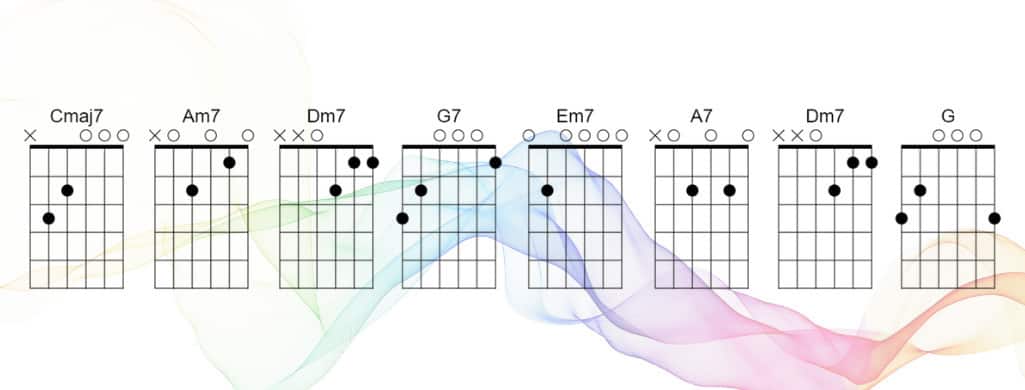
Imaj7 – vi7 – ii7 – V7 – iii7 – VI7 – ii7 – V7 (Cmaj7 – Am7 – Dm7 – G7 – Em7 – A7 – Dm7 – G7)
Jazz progressions can get complex, but this particular progression is not as scary as it may look. All of the chords are sevenths, but that shouldn’t bother a jazz fan.
You can break this progression down into four sections of two each. Depending on the song, you’d likely play each of those sections over two bars, but they’d sometimes be crammed into one.
The second and fourth sections are the same, so that should help you master the entire progression in no time.
Some jazz staples that use this pattern are:
- “Long Ago and Far Away” by Earl Klugh
- “Cheek to Cheek” by George Van Eps
- “Isn’t It Romantic” by Tal Farlow
More Jazz
Discussing every jazz progression could literally be part of a university course, and will take you a while to master. While the above examples are common, they are only a small taste of what jazz has on offer.
For instance, many jazz progressions will repeat chords, but modulate them ascending or descending each time it is played over a certain amount of bars. This subtly changes the key of the song as you play. It’s an awe-inspiring feat, but perhaps better tackled in its own dedicated lesson.
• • •
R&B Progressions
Just like many other genres, rhythm and blues has its roots in blues music. So, it borrows quite a few tricks from it. Most R&B doesn’t have to have super complex chords, especially when it comes to guitar.
R&B tracks often avoid using the tonic in their progressions. This allows them to keep a bouncy feel, especially when combined with a stellar beat.
Like with funk music and live instrumentation, R&B producers often layer a ton of different tracks into one song. So a few simple chords from a guitar usually does the job. It’s one of the few genres where the bass gets to be the star.
There are often no guitar tracks in R&B songs at all, so you may have to adjust the way you play the rhythm to keep the song interesting for your audience.
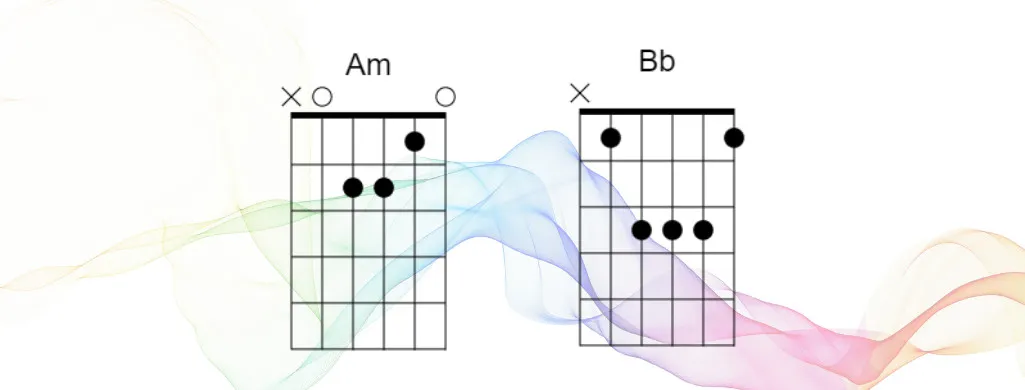
vi – bVII (Am – Bb)
Here we have another example of a track using a flat chord to build tension. Progressions sound a little off when they’re on their own like this, but it can sound phenomenal as part of a whole track.
A prime example of this progression is “This Is How We Do It,” by Montell Jordan. While it sounds great in this track, we wouldn’t recommend writing a song on your acoustic guitar with these chords. It needs more with it to work.
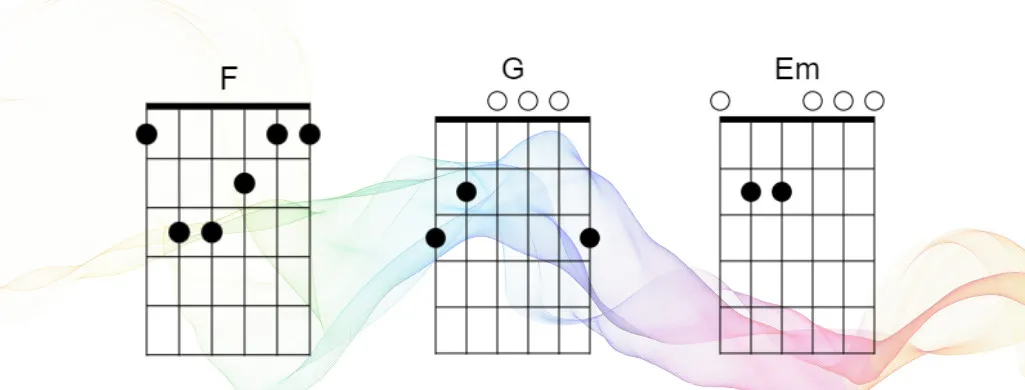
IV – V – iii (F – G – Em)
Resolving on a minor and not featuring the tonic of the scale makes this one of the best sad chord progressions. Perfect for songs about heartbreak, which is a common theme in R&B.
“We Belong Together,” by Mariah Carey is a great example of how these chords work together.
• • •
Chord Progressions FAQ
We’ve got you covered whether you’re still unsure about a few things or just skipped ahead to the FAQ to learn a little quicker.
What Are the Best Guitar Chord Progressions?
For beginners, the best progression you can learn is the common Major and minor 4 progressions of:
Major I – V – vi – IV (G – D – Em – C)
Minor i – VI – III – VII (Em – C – G – D)
These particular variations of the common progressions allow you to play songs without worrying about barre chords. You can also easily switch up the key by using a capo.
How Would I Know When to Play a Minor or a Major Chord in the Chord Progression?
The most important thing to do in regards to knowing when to play a major or minor chord is to learn the scales and train your ear. There’s no real shortcut, unfortunately. Eventually, when you’re playing a progression, you’ll be able to tell before you play it whether a major or minor version fits.
What Makes a Good Chord Progression?
Making a good progression depends on its purpose. Sticking to the rules and resolving on certain steps in the scale is great for most popular styles of music. But, other progressions may want to add some intrigue or tension, which means you’ll do something different.
For example, you may add some sevenths or major sevenths, to change it up a little.
• • •
Crafting the Perfect Chord Progression
We hope this article cleared a few things up for you regarding chord progressions and gave you a direction to send your practice. This stuff isn’t easy, which is why we always recommend taking guitar lessons.
When making your own blues progression, or any other style in modern music, you can start with a popular progression and make a few changes to make it more interesting. Try changing up the sequence or messing with the structure of the individual chords to make something unique. Study the progressions underneath the really great songs (1) to get some inpiration.
Remember that all guitar players had to start somewhere, and even the smallest bursts of progress stack up. It will take a while from strumming one chord to playing all of them. Stick with it and keep on practicing.
References:
- Ultimate Guitar, “Best Chord Progressions: Songs With The Best Chord Progressions Ever,” as published here: https://www.ultimate-guitar.com/collections/1087821/

